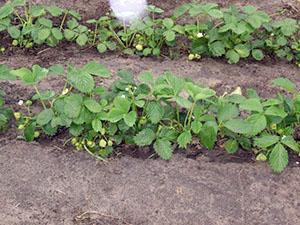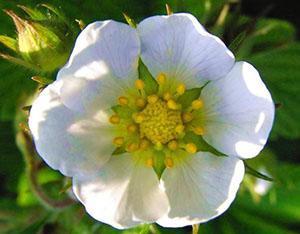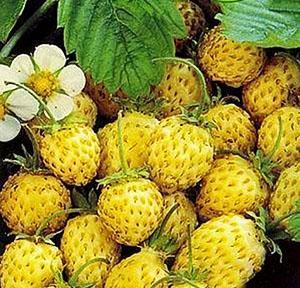Repairing strawberries: planting and caring for it
 The popularity of remontant strawberries, the care of which everyone can master, is explained by the fact that it gives two or even three harvests per season. This allows you to enjoy the taste and aroma of the berry from the first hot days to the onset of cold weather. Such varieties differ from garden ones in that their bushes are smaller. However, this does not affect the taste of strawberries and its usefulness. Plants quickly form new buds after the previous crop has been harvested, which requires a lot of energy from the plant. For this reason, the care of strawberries of these varieties is special.
The popularity of remontant strawberries, the care of which everyone can master, is explained by the fact that it gives two or even three harvests per season. This allows you to enjoy the taste and aroma of the berry from the first hot days to the onset of cold weather. Such varieties differ from garden ones in that their bushes are smaller. However, this does not affect the taste of strawberries and its usefulness. Plants quickly form new buds after the previous crop has been harvested, which requires a lot of energy from the plant. For this reason, the care of strawberries of these varieties is special.
Features and care of strawberries, its varieties

Varieties with small fruits are unpretentious, resistant to heat and frost. Their landing is easier due to the fact that they do not develop tendrils. Markings "DSD" or "NSD" can be deciphered as varieties for long and neutral daylight hours. When purchasing any of the varieties, you need to find out about the method of its reproduction, cultivation, about resistance to pests and diseases. Some gardeners choose hybrids - species obtained by crossing different varieties. They rarely get sick and are less likely to be affected by pests, and hybrids also have higher yields. Their disadvantage is the lack of the ability to reproduce. Hybrids are designated as F1.
Features of some of the popular varieties are shown in this list:
- Alexandria is a small-fruited strawberry variety that propagates by seed. Possesses great frost resistance and good "immunity".
- The Ali Baba variety is very similar to Alexandria in its characteristics. Produces a good harvest. Strawberries of this variety are very tasty.
 Snow White is also a small-fruited strawberry that is propagated by seeds. The yields are quite abundant. The berries themselves taste like pineapple and have white flesh, for which they got their name.
Snow White is also a small-fruited strawberry that is propagated by seeds. The yields are quite abundant. The berries themselves taste like pineapple and have white flesh, for which they got their name.- Experts choose the American strawberry variety Diamant for its resistance to disease and frost, as well as for its large berries. They have an elongated shape, orange-scarlet color, characteristic shine and amazing taste. The yield of this variety is also high.
 The variety, originally from the Netherlands, Vima Rina is also distinguished by large fruits, resistance to drought and disease. It can be recognized by its dark, slightly curled leaves. Wim Rina's berries are pointed, red, with a sour taste. The density of these berries allows them to be successfully transported.
The variety, originally from the Netherlands, Vima Rina is also distinguished by large fruits, resistance to drought and disease. It can be recognized by its dark, slightly curled leaves. Wim Rina's berries are pointed, red, with a sour taste. The density of these berries allows them to be successfully transported.- Queen Elizabeth is a Russian variety with large berries that are well suited for neutral daylight hours. He has tall bushes, a little mustache, the berries are cone-shaped and have a sour-sweet taste. Their flesh is dense, which makes them easy to transport. The yield of this variety is high - up to 3 kg of berries from each bush can be obtained per season.
 The Laurent variety is marked F1, that is, it is a hybrid, it also has the designation NSD. The bush of this variety is powerful, has large leaves and dark red berries with a sweet, slightly sour taste. It can be grown in the middle lane.
The Laurent variety is marked F1, that is, it is a hybrid, it also has the designation NSD. The bush of this variety is powerful, has large leaves and dark red berries with a sweet, slightly sour taste. It can be grown in the middle lane.- The Inexhaustible Strawberry is a German variety. Its bushes can be recognized by its large, dark leaves. The fruits are delicious and large. The second collection of berries from these bushes is carried out relatively late, so it is convenient to freeze these berries for the winter.
Planting, growing and caring for remontant strawberries
The strawberry plantation should be constantly renewed. This is usually done in late July or early August. Before the onset of autumn, the bushes have time to take root and prepare for wintering. So, you need to choose antennae with well-developed rosettes and plant them. The flower stalks that appear on them should be removed so that the bushes will give an early harvest next season. At the end of summer, you need to repeat the replanting. Such way of growing strawberries it is best to practice with NSD varieties.
Strawberries need light soil with a neutral pH. The plant is usually planted in the spring, but you can do this at the end of August. Planting method - nesting. Renovation strawberries, which are somewhat more difficult to plant and care than garden strawberries, need more space. It is necessary so that new shoots can take root. Plot in front planting strawberries dig up and fertilize. Strawberry care in spring (in April) consists in preparing the soil - manure is introduced into it. Sand is also added to heavy soil. The plants are planted in mid-May. At least 65-75 cm is left between the holes. Young bushes require daily watering. And the autumn landing is actually carried out at the very end of summer.
 Repaired varieties need to be watered often; water for this purpose must be taken warm. An infusion of herbs - nettle, wormwood and yarrow - is useful for strawberries. They are crushed and poured with water, left in the sun and after 7 days used for watering. After watering or good rain, you need to gently loosen the soil at the roots. Pruning strawberries is also considered important in care.
Repaired varieties need to be watered often; water for this purpose must be taken warm. An infusion of herbs - nettle, wormwood and yarrow - is useful for strawberries. They are crushed and poured with water, left in the sun and after 7 days used for watering. After watering or good rain, you need to gently loosen the soil at the roots. Pruning strawberries is also considered important in care.
The mustache should be trimmed regularly. In the fall, it is necessary to prepare the bushes for winter - remove all flower stalks, cut off the leaves.
It is also necessary to check that the roots are not exposed. The land must be loosened up, and then the plantings must be mulched with deciduous humus. The bushes are covered with grass only with the onset of frost. Insect pest control and disease prevention are carried out both in spring and autumn. Just like garden strawberries, repair varieties also require care. Even more intense. But the harvest is richer.
The agricultural technique of remontant strawberries differs from the berries that bear fruit once. With such intensive development and continuous fruiting, the removal of nutrients from the ground is much greater. Therefore, during the growing season, feeding should be done systematically. It is not clear to me how then you can get an ecological product? For a vegetable garden without the use of fertilizers, perhaps the best scheme would be to grow the plant for two years, followed by relocation to another filled and prepared area.
But I tried to cut the flower stalks in the fall, so as not to weaken the bush. The more I removed them from the remontant bush, the more they appeared. I thought I was preparing the bush for winter, but it did not come to life in the spring. Apparently, while he fought for the right to harvest, he weakened. Nearby there was another bush, which with a berry went under the snow, he survived. Variety one, care was the same. I'm not sure of my conclusion, but it was.
Hello! I planted Ali Baba strawberry seedlings, the dawn is Roman and all the repair ones, because there was no mustache anywhere. Planted "beautifully" in tires, a whole row of three roots. Developed rapidly, fertilized the earth with everything they recommend. Produced generously for the joy of grandchildren in the first season. Until the very frost.For the winter, I did not cut the foliage, left it to winter, put metal arcs above the planting, just above the bushes and covered it with white covering material (twice) along the arcs, attached it with clothespins, and then covered it with all kinds of jackets and lips. In winter, they also covered it with snow. And now spring, and it looks like my strawberries are dead! Can still make ridges at ground level? Car tires are not good read a lot, took on beautiful ridges? Or maybe not for our regions such a berry, only for one season? Trans-Baikal Territory, but southeast at the very border. Questions, questions and no answer. And again, Elizabeth Koroleva grew 8 bushes over a new one, and from Chelyabinsk came Alba, crown, Ostap and Roxana, will these varieties overwinter, and how to plant them correctly.?
I have my own house, there are surplus remontant strawberries Tell me when you can plant remontant strawberries in cups so that they will be with berries for sale by spring. to remove to the cellar, and plant a little later?
Repaired strawberries have long been successfully grown in apartment conditions. If you have the opportunity to provide the plants with good lighting and temperature, feel free to start planting, especially since November is approaching - the best time to "relocate" young strawberry rosettes from the garden to the house.
The only thing is that in this case (with proper care) the first crop will ripen before spring comes - about two months after planting. As for the cellar, the plants will have to be kept there until the end of February at least - there is a risk that in a room with high humidity the bushes will begin to germinate and by that time will be very long. But you can put several pots there "for trial" in order to delay fruiting, and draw your own conclusions based on the result obtained. Experiment.